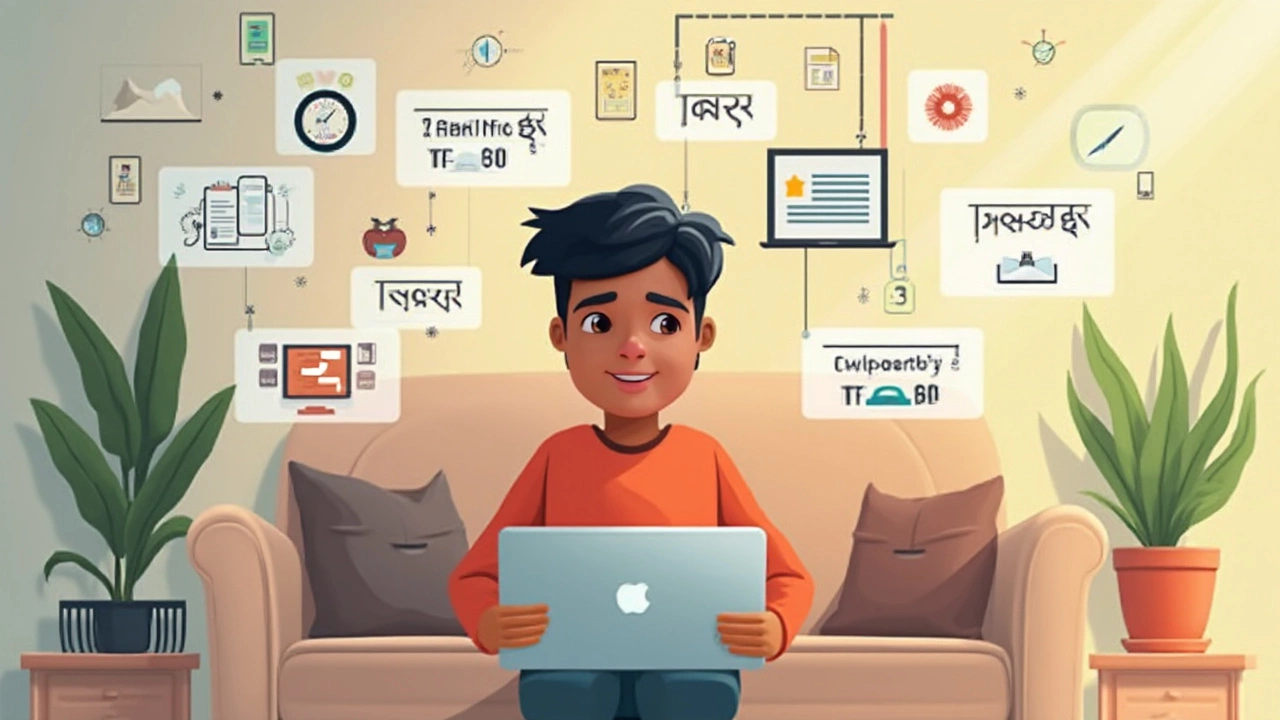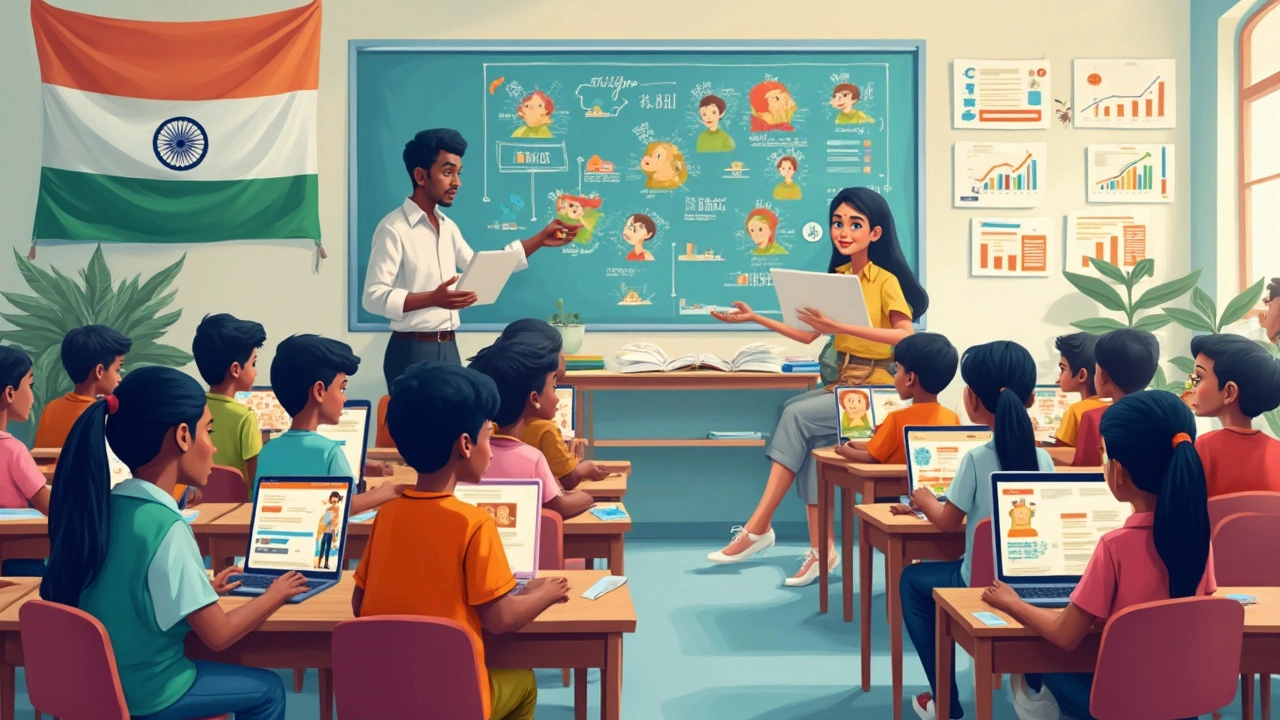Ever heard someone call it eLearning, then someone else says distance learning, and at work they just say online training? It’s not just you—people throw around a ton of labels for the same thing, and it gets messy fast. eLearning is the blanket term for learning that happens with the help of digital technology, usually over the internet. But that’s not the only term you’ll bump into.
Schools and businesses like to get creative, or just picky. Some talk about virtual classrooms, remote learning, digital education, web-based training—the list goes on. Each term hints at where or how the learning happens. For example, a 'virtual classroom' often means live classes with a teacher online, while 'eLearning' can be more about self-paced stuff like videos or quizzes.
There’s a reason all this matters. If you’re trying to find a good learning platform, the words they use can clue you in on what to expect. Do you want real-time help from an instructor? Look for 'virtual classes.' Prefer to learn by yourself at midnight? Stick with 'eLearning' or 'self-paced modules.' Knowing the lingo makes a difference, especially when every website promises 'the best' learning experience but means something a little different.
- The Many Names for eLearning
- How the Terms Differ (and Where They Don't)
- Why Labels Matter for Learners and Educators
- Tips for Picking the Right eLearning Platform
The Many Names for eLearning
If you start googling online education, the names multiply fast. Ever noticed how job ads or school websites mention 'online learning,' 'distance education,' or even 'virtual classrooms'? It's not just about different words—each label points to a certain way of learning or delivering education. Over the years, as tech and teaching have changed, the list has only grown longer.
Here's a quick roundup of the labels you’ll see most often with a quick-hit explanation for each:
- eLearning: The most common term for digital, internet-based learning. It covers everything from quick workplace tutorials to full college degrees online.
- Online Learning: Pretty much a twin to eLearning, but people sometimes use it when talking about live online classes or bigger programs.
- Distance Learning: Highlights the physical distance. Usually means the student and teacher aren't on the same campus and often not even in the same country.
- Virtual Classroom: This is when classes happen live, but the classroom is inside a tool like Zoom, Google Meet, or Microsoft Teams. You can talk to teachers or other students in real time.
- Digital Education: Even broader. This can mean any teaching where tech is the main piece—could even be apps, games, or recorded lessons on YouTube.
- Remote Learning: Became popular when schools shut physical buildings and had to teach everything from home, like during the COVID-19 quarantine in early 2020.
- Web-based Training (WBT): You'll see this in workplaces or skills courses. It's usually a mix of videos, readings, and quizzes delivered through a browser.
The terms also pop up differently when you cross over into businesses. Corporate training teams might say 'Learning Management System (LMS)' for their portal, or talk about 'asynchronous' (learn on your schedule) and 'synchronous' (everyone logs in at once) options.
It can get a bit much, so here’s a table breaking down which terms are used where, and by whom:
| Term | Commonly Used By | Typical Situation |
|---|---|---|
| eLearning | Schools, companies | Covers all forms of digital learning |
| Online Learning | Schools, tutors | Live online classes and courses |
| Distance Learning | Universities, adult ed | Programs for students far away |
| Virtual Classroom | Teachers, coaches | Live classes on Zoom or Teams |
| Web-based Training (WBT) | Corporate HR, skills trainers | Staff training modules and certification |
| Remote Learning | K-12 schools, families | Learning from anywhere outside the school building |
Certain labels may stick depending on the country. For example, UK universities lean toward 'distance learning,' while US workplaces love 'web-based training.' It all means that when you see six names for what looks like the same thing, they’re probably talking about slightly different flavors of digital education. The main takeaway? Don’t get hung up on the buzzwords—focus on what you need out of your learning experience.
How the Terms Differ (and Where They Don't)
This is where things get a little confusing. People love mixing up the terms—sometimes on purpose, sometimes not. But if you're hunting for the right kind of learning or a platform that really fits your needs, knowing what each buzzword means will save you time and headaches.
So, what actually splits these up?
- eLearning: This is the broad umbrella. It’s digital learning—usually online, often on a platform with lessons, videos, and quizzes. You don’t have to show up at a certain time. It’s basically "learn when and where you want." Most big platforms like Coursera or Udemy fall here.
- Online Learning: This overlaps a lot with eLearning. It’s any education that happens over the internet. The terms get swapped around by most people, but ‘online learning’ sometimes gets used by schools for regular courses just moved to a website.
- Virtual Classroom: Here you’re logging in at a set time to a live, online class with a teacher and maybe other students. There's real-time feedback. Think of it like Zoom school or live webinars.
- Distance Learning: This started way back with mail-in lessons but now just means studying away from a physical campus, sometimes with printed stuff, sometimes digital.
- Web-Based Training: Mostly found in offices. It’s about skill upgrades—watch a video, take a quiz, move to the next level. Great for job certification stuff.
And honestly, most of these terms blur together now because of how technology connects people. You might take a live course online (virtual classroom) but also get recorded videos for later (eLearning).
| Term | Example | Live/Self-paced | Main User |
|---|---|---|---|
| eLearning | Self-paced math tutorials | Self-paced | Students, employees |
| Online Learning | School courses over a website | Both | Schools, universities |
| Virtual Classroom | Zoom-based science class | Live | Teachers, students |
| Distance Learning | Courses for remote students | Both | People living far from campus |
| Web-Based Training | Company compliance videos | Self-paced | Employees |
Here's the bottom line: it’s less about the perfect label and more about what feels right for your life and schedule. Don’t stress about the terms—just use what gets you the right learning tool for your goal.

Why Labels Matter for Learners and Educators
If you’ve ever signed up for a course and realized it’s nothing like you expected, you know how much words matter. What a school or company calls its programs can tell you a ton about what’s actually on offer. For example, calling something eLearning usually means you’ll be using tech, often at your own pace, without set times to show up. On the other hand, if it’s labeled as a 'virtual classroom,' get ready to tune in for live sessions with a teacher and classmates, webcam faces and all.
The labels aren’t just for show—they can decide things like how much freedom you get, if you need to show up at a certain time, or if you get to interact with others. Here’s why that’s such a big deal for learners and educators both:
- Expectation Setting: If the label says 'self-paced,' students know they can fit lessons around their work or family life. Teachers know what support to give (less hands-on, more pre-made content).
- Matching Needs: Some students want live feedback; others just need module checklists. Picking the right type saves a lot of frustration.
- Skill Recognition: On a resume, saying you completed 'distance learning' at a university might land differently than if you went through a corporate 'online training.' Employers often care about both the platform and the format.
- Access and Tech Requirements: Not every label means the same tech setup. 'Digital education' could be an app on your phone, but 'virtual classroom' might demand broadband internet, a webcam, and a distraction-free spot at home.
Let’s break down how these labels show up across different learning environments:
| Term | What to Expect | Common Places Used |
|---|---|---|
| eLearning | Self-paced, video lessons, quizzes, forums | Universities, big name platforms like Coursera |
| Virtual Classroom | Live sessions, group chats, real-time Q&A | K-12 schools, online tutoring companies |
| Online Training | Focus on workplace skills, certification modules | Corporate programs, HR onboarding |
| Distance Learning | A mix: some self-paced, some live check-ins | Mature colleges, global universities |
| Digital Education | Can be broad: apps, online courses, even YouTube | EdTech startups, experimental learning apps |
A 2024 report from Global Industry Analysts noted that the worldwide eLearning market hit almost $400 billion, with nearly 65% of students saying they chose programs based on whether they could study on their own time. That’s why these labels aren't just marketing fluff—they help everyone land in the right spot for how they want to learn or teach. When you know the terms, you waste less time, money, and patience hunting for the right fit.
Tips for Picking the Right eLearning Platform
Honestly, with hundreds of eLearning platforms out there, it's easy to feel lost. Don't just sign up for the first one that pops up on Google. Here’s what actually matters when picking the right platform, whether you’re a solo learner, a teacher, or wrangling a whole team at work.
- Content Quality Matters Most: Not every course out there is built the same. Check to see if the platform works with real educators or industry experts. For job skills, sites like Coursera and LinkedIn Learning often partner with legit universities and top companies.
- Flexibility Is Key: Are you after live sessions or videos you can watch anytime? Platforms like Udemy and Skillshare are great for self-paced learning, while Zoom-based setups (like Outschool) focus on interactive, live sessions.
- Device Compatibility: If you like learning on your phone, make sure the platform has a decent mobile app. Fun fact: In 2024, over 58% of online learners said mobile access was a dealbreaker.
- Real Progress Tracking: Some platforms come with built-in quizzes, badges, or even certificates. If you need proof for work or school, check what kind of completion records they hand out.
- Community and Support: Learning online can get lonely. Forums, chat support, and peer groups help you stay on track.
Sometimes stats help make things click. Here’s how the big platforms stack up (latest available public data):
| Platform | Self-paced or Live | Courses Offered | Mobile App | Certificate |
|---|---|---|---|---|
| Coursera | Both | 7,000+ | Yes | Yes |
| Udemy | Self-paced | 210,000+ | Yes | Yes |
| LinkedIn Learning | Self-paced | 21,000+ | Yes | Yes |
| Outschool | Live | 140,000+ | Yes | No |
If you’re picking for a whole organization or school, ask about privacy and analytics, too. Many platforms can track who’s done what and how well they did (think LMS—Learning Management System features). Try free demos. No sense paying before you see how it actually feels. The best advice? Trust your gut, but back it up with some quick research, and if you get stuck, ask people already using the platform.





